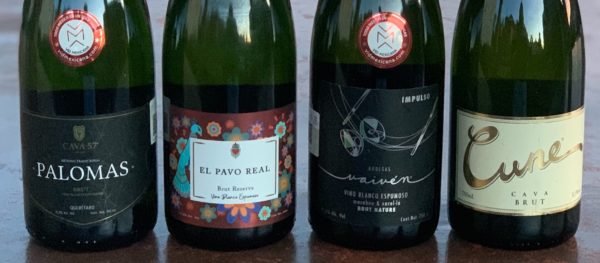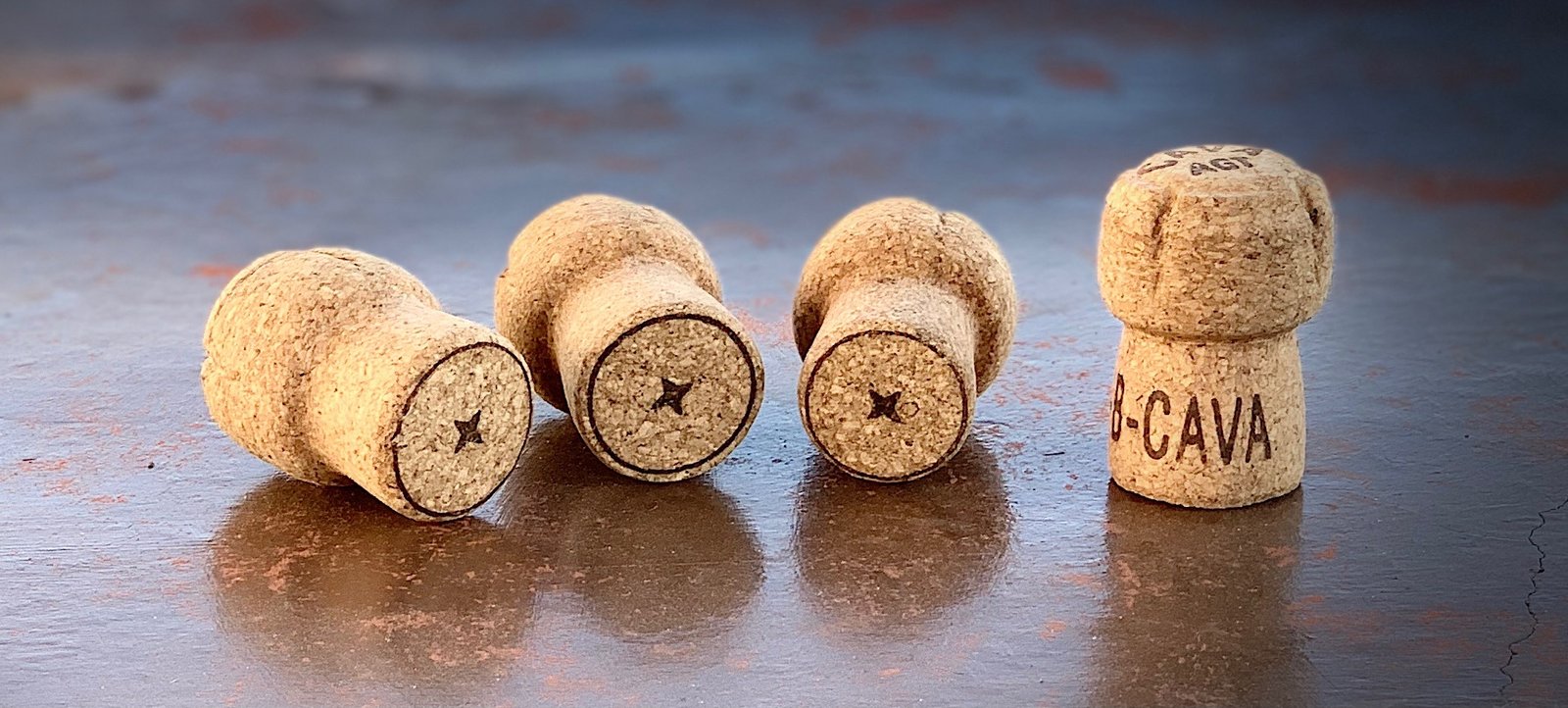Underneath our staircase, you’ll find a wine rack and, in that wine rack, you’ll usually find it about half full of chubby bottles topped with foil and wire. These bottles contain Don Day’s Wife’s all-time, without-a-doubt, very best favorite beverage. Sparkling wine.

Usually these bottles have emigrated from one of three different homelands. There are the Proseccos from Italy. There are the Cremants from France. There are the Cavas from Spain. Lately though there have also been some space invaders in our little lock-up, local contenders trying to win a few slots in the rack amongst the European invaders.
There are now at least seven Queretaro wineries producing Vino Espumoso Brut. With my desire to go local for almost everything we eat and drink, I think we’ve now sampled all of the locally available sparklers that fit into our $500 max price range. The best we’ve found are the ones that mirror the style of the Spanish Cavas and use Macabeo, Xarel-lo and Parellada as their primary grapes.

Last Sunday, I joined Don Day’s Wife by also choosing to drink my juice from a flute. I asked her to help me decide how three of those local rookies compared with a longtime Spanish champion by doing a side-by-side, sip-by-sip, swallow-by-swallow comparison.
Now, evaluating wines is a very tricky and very controversial subject. The ratings standard is named after wine’s most famous critic and is referred to as the Robert Parker system. It scores wine between 50 and 100 but most wines that are worthy of being poured into a glass fall somewhere between 80 and 100. I separate them into 80-85 being good, 85-90 being very good, 90-95 exceptional, and 95-100 extraordinary (and almost always unaffordable).
Now, as much as I dislike the Robert Parker system, I’ve struggled to find a better alternative. So that’s the numbering system we used to rate the sparklers. But our methods are a little different. Wine critics include things like clarity, acidity, nose in their scores. Don Day’s Wife and I are all about taste and almost only about taste.

So here are a few facts about each of the four wines, what we liked (or didn’t), and how we scored them.
Vaiven Impulso Espumoso Brut Natura.

This winery is an almost total mystery to me; their website is one blank white page. The busy label isn’t much of an enticement either. What did entice me was the cost. At $284, it’s the lowest priced brut sparkler on Vid Mexicana’s website. It’s a blend of two grapes, Macabeo and Xarel-lo, and, with 11 months in the bottle and 11.5% alcohol, it very much parallels classic Cavas. What is a little different is the sugar content; at 4.2 grams per litre, it’s dryer than almost all Spanish Cavas.
Our first reaction was, “Nice, this could be a Spanish Cava.”
Impulso had the typical taste of green apple plus a little pear but what put us off was the aftertaste. Citrus can be a desirable taste with certain white wines but this was a grapefruit rind taste that was just a little too bitter. We gave Impulso an 82.
Cava 57 Palomas Brut

This espumoso also comes from Vid Mexicana (my first choice of retailers for Mexican wine) and is priced at $303. The winery and their sparklers received a little claim to fame when it was featured in Food and Wine magazine. Palomas is quite local, coming from San Juan del Rio, just over an hour from San Miguel de Allende. It’s a blend of the three primary Cava grapes, spends 12 months in the bottle, has 11.5% alcohol and 12g/l of sugar.
We also had a positive first reaction to Palomas. Again there was that Cava taste of apple but this time there was also the fresh bread taste that we associate with fine Champagnes. Don Day’s Wife gave it very high praise when she said, “I’d definitely drink this again.” Our average score for Cava 57 Palomar was an 88.
El Pavo Real Brut Reserva. $400.

El Pavo Real is located off the road to Queretaro, just 20 minutes from San Miguel. Until their own vineyards are mature, they’re sourcing their product from another local winery. It’s a blend of Macabeo and Xarel-lo plus Ugni Blanc, a grape you won’t find in any Spanish Cavas. It again has 11.5% alcohol and spends a full 18 months in the bottle. You’ll have to order this one from the winery but they do deliver.
Pavo Real had that same wonderful mouth feeling you get from European sparklers, the result of more and smaller bubbles. Again, there was the pleasant taste of apples and pears. Again, Don Day’s Wife OK’d a space under the stairs for it. It was primarily the higher price that put it one point behind the Palomas at 87.
Cune Cava Brut. $259.

The fourth sparkling wine in the contest was the Cava. I chose Cune (or Cvne) to represent Spain because, the last time I was in Spain, a couple of years ago, it was the Cava I saw most often on the shelves of bars and restaurants and shops. Having researched and written about Cune in the past, I’d guess that their Cava probably sells a thousand times more bottles than all Queretaro sparklers combined.
In San Miguel de Allende, Cune is available at our local supermarket, La Comer. Macabeo, Parellada and Xarel-lo are the grapes. It spends nine months in the bottle and, like the Mexican bubblies comes in at 11.5% alcohol.
The Cune had that same foamy mouth feeling we got from Pavo Real and, in addition to the apple taste, there was a hint of peach. What we thought was lacking was the freshness we felt from the Mexican challengers. That being said, with such an attractive price tag, six of those slots in our rack under the stairs now hold a Cune. In our tasting, it scored an 85.
So, with Mexico coming first and second in our contest and beating an established world leader in the world of sparkling wine, what did we prove? Well, this isn’t the first time we’ve put Mexican wines up against the rest of the world in our little tastings. We’ve done it a few times over the last ten or so years. But this is the first time ever that Mexico has won. Which says a lot for the progress of Mexico as a wine country and, perhaps, even more for Queretaro as a wine region.

The price of most Mexican (and Queretaro) wine is still a hindrance but we’re going to try even harder to buy local. I hope you do too.
You will find Palomas and Impulso at vidmexicana.com. You will find El Pavo Real at https://m.facebook.com/elpavorealdelcampo/. You’ll find Cune at lacomer.com.mx.


I too like to buy local but I hope you have the chance to try Costco’s Kirkland French Champagne. At about $600 it is much cheaper than the “brands.” It is from a boutique vineyard in Champagne, I believe Jannison. It is excellent
Yes, a great value. It’s scheduled for our table on Valentine’s Day. Another great Costco bubbly is Baron Maxime Cremant de Limoux.